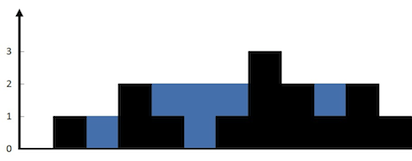42. Trapping Rain Water
Description
Given n non-negative integers representing an elevation map where the width of each bar is 1, compute how much water it can trap after raining.
Example 1:

1 | Input: height = [0,1,0,2,1,0,1,3,2,1,2,1] |
Example 2:
1 | Input: height = [4,2,0,3,2,5] |
Constraints:
n == height.length1 <= n <= 2 * 10^40 <= height[i] <= 10^5
Hints/Notes
- 2024/12/20
- two pointers or monotonic stack
- 0x3F’s solution(checked)
Solution
Language: C++
1 | class Solution { |
monotonic stack
1 | class Solution { |